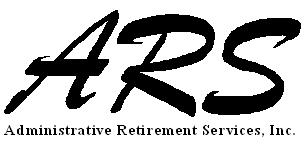A Defined Benefit Plan (DBP) is a type of plan that Administrative Retirement Services, Inc. normally only recommends for companies that have no employees other than the business owners and spouses. A DBP is a type of pension plan that provides the business owners larger contributions than can be contributed to a 401(k) profit sharing plan or SEP. The annual contributions are calculated by a licensed actuary based upon actuarial methods and assumptions.
The Benefit
In as short as five years a business owner can contribute a significant amount of money that is deductible annually as a business expense and grows tax deferred. When plan assets are distributed, the business owner will be retired and in a lower tax bracket, thus paying less in taxes.
Numerical Example
Example for owners aged 50 and 55.
| Name | Age | Wages | 401(k) | Employer Profit Sharing | Employer Defined Benefit | Total |
| Owner 1 | 55 | 265,000 | 24,000 | 15,900 | 167,000 | 206,900 |
| Owner 2 | 50 | 265,000 | 24,000 | 15,900 | 127,000 | 166,900 |
| Total | 530,000 | 48,000 | 31,800 | 294,000 | 373,800 |
More Detail
Defined benefit plans are qualified employer-sponsored retirement plans. A defined benefit plan guarantees participants a certain monthly benefit when they retire based on factors such as wages earned, age, and years of service with the company.
Retirement benefits in a defined benefit plan are based on a formula that is written in the plan document. This formula can provide for a set monthly dollar amount or for a specified percentage of earnings. Many plans calculate an employee's retirement benefit by using average employee earnings during the last few years of employment or, alternatively, averaging an employee's earnings for his or her entire career, taking a specified percentage of the average, and then multiplying it by the employee's number of years of service. Some defined benefit pension plan formulas also reduce pension benefits by a percentage of the amount of Social Security benefits you can expect to receive.
There are two types of defined benefit plans (DBP), traditional defined benefit and cash balance plans. Employers that have employees should consider establishing a cash balance plans instead of a traditional defined benefit plan because CBP provide more flexibility in annual contributions and plan termination. DBP plans require that annual contributions and benefits are calculated by an enrolled actuary. The actuary must be licensed and must confirm the accuracy of the assumptions used in the plan.
The number of DBPs has reduced significantly over the years due to cost and complexity of these plans. Still, a DBP may be an excellent option for successful business owners that want to shelter large amounts of income into a retirement plan. Employers can generally contribute (and, therefore, deduct) more than to a DBP than to other types of retirement plans.
Plans sponsors can establish a defined benefit plan and have a defined contribution such as a 401(k)) Plan. Annually the plan must file a Form 5500 with a Schedule B that is completed by an enrolled actuary who has determine the funding levels and sign the Schedule B. Benefits cannot be retroactively decreased.
The advantages of DB plans are:
• Significant benefits possible in a relatively short period of time.
• Employers can contribute and deduct more than under other retirement plans.
• Plan provides a predictable benefit.
• Plan can be used to promote certain business strategies by offering subsidized early retirement benefits.
The disadvantages of DB plans are:
• Most costly type of plan.
• Most administratively complex plan.
• An excise tax applies if the minimum contribution requirement is not satisfied.
Money Into the Plan
Normally, the employer makes all contributions to DB plans. The contribution limit is any amount up to the plan’s unfunded current liability.
Money Out of the Plan
Participant Loans may be permitted. In-Service Withdrawals are not permitted.
Many defined benefit plans allow you to choose how you want your benefits to be paid upon termination. Payment options commonly offered include:
A single life annuity: You receive a fixed monthly benefit until you die; after you die, no further payments are made to your survivors.
A qualified joint and survivor annuity: You receive a fixed monthly benefit until you die; after you die, your surviving spouse will continue to receive benefits (in an amount equal to at least 50 percent of your benefit) until his or her death.
A lump-sum payment: You receive the entire value of your plan in a lump sum; no additional payments will be made to you or your survivors.
Choosing the right payment option is very important, since the option you choose can affect the amount of benefit you ultimately receive. You'll want to consider all of your options carefully, and compare the benefit payment amounts under each option.
Benefits do not hinge on the performance of underlying investments, so you know ahead of time how much you can expect to receive at retirement.
Set Up This Plan
To setup this plan for your organization, please complete our Online Questionnaire.
You may also complete the questionnaire offline by downloading the form here and then faxing the completed form to our office.

